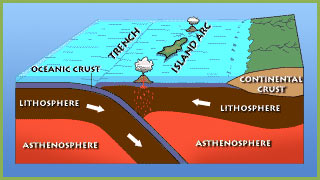Slip, Slide, & Collide
At convergent boundaries, tectonic plates collide with each other. The events that occur at these boundaries are linked to the types of plates — oceanic or continental — that are interacting.
Subduction Zones and Volcanoes
At some convergent boundaries, an oceanic plate collides with a continental plate. Oceanic crust tends to be denser and thinner than continental crust, so the denser oceanic crust gets bent and pulled under, or subducted, beneath the lighter and thicker continental crust. This forms what is called a subduction zone. As the oceanic crust sinks, a deep oceanic trench, or valley, is formed at the edge of the continent. The crust continues to be forced deeper into the earth, where high heat and pressure cause trapped water and other gasses to be released from it. This, in turn, makes the base of the crust melt, forming magma
The magma formed at a subduction zone rises up toward the earth's surface and builds up in magma chambers, where it feeds and creates volcanoes on the overriding plate. When this magma finds its way to the surface through a vent in the crust, the volcano erupts, expelling lava and ash. An example of this is the band of active volcanoes that encircle the Pacific Ocean, often referred to as the Ring of Fire.
 Illustration depicting how island arcs are formed. |
A subduction zone is also generated when two oceanic plates collide — the older plate is forced under the younger one — and it leads to the formation of chains of volcanic islands known as island arcs. Examples include the Mariana Islands in the western Pacific Ocean and the Aleutian Islands, off the coast of Alaska.
Since the collision and subduction of plates is not a smooth process, large, powerful earthquakes are another phenomenon that result from this type of interaction. Earthquakes generated in a subduction zone can also give rise to tsunamis. A tsunami is a huge ocean wave caused by a sudden shift on the ocean floor, such as an undersea earthquake. If the wave reaches land, it can cause incredible destruction, like the Asian Tsunami, which killed more than 200,000 people in 11 countries across the Indian Ocean region in December 2004.
Collision Zones and Mountains
What happens when two continental plates collide? Because the rock making up continental plates is generally lighter and less dense than oceanic rock, it is too light to get pulled under the earth and turned into magma. Instead, a collision between two continental plates crunches and folds the rock at the boundary, lifting it up and leading to the formation of mountains and mountain ranges.
An example of this mountain-building process is the Himalayan range in southern Asia. Containing the highest mountain peaks in the world and traversing the modern-day countries of India, Pakistan, China (Tibet), Bhutan, and Nepal, the Himalayas were formed by the collision of the Indian and Eurasian Plates. This process began after the breakup of Pangaea, when India became an island continent and began traveling northward toward Asia. The island of India slammed into Asia about 40 to 50 million years ago near modern-day Tibet, crushing and folding the plates to form the Himalayan mountain range. Its best known peaks, Mount Everest and K2, are among several that measure over 8,000 meters (26,000 feet) high at their summits. Since the Indian Plate is continuing in its northward movement into Asia, the Himalayas continue to grow higher each year by small amounts (5 to 20 mm or 1 inch per year).